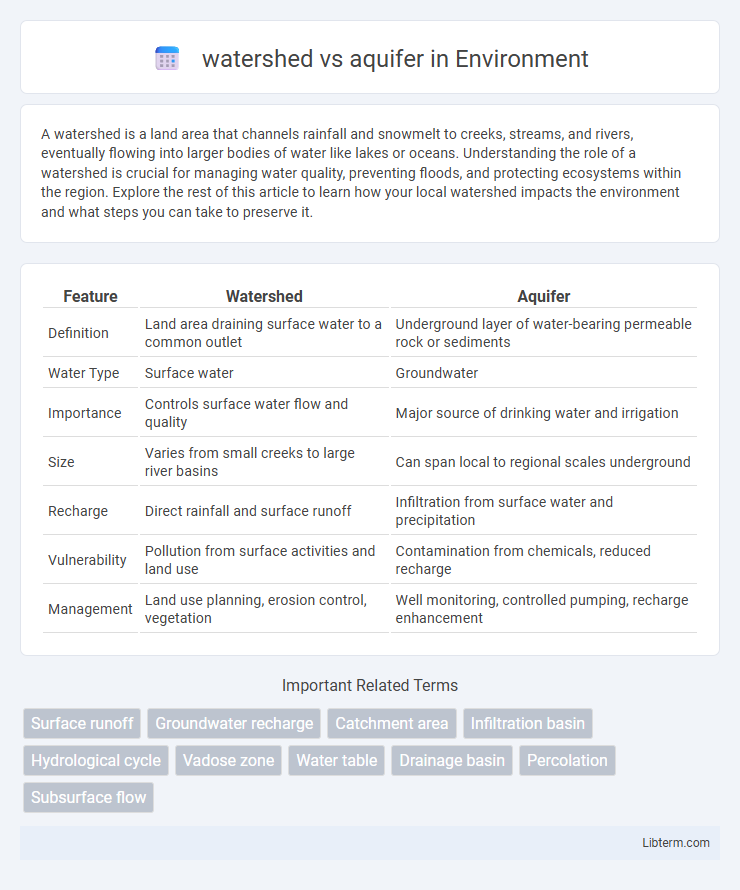A watershed is a land area that channels rainfall and snowmelt to creeks, streams, and rivers, eventually flowing into larger bodies of water like lakes or oceans. Understanding the role of a watershed is crucial for managing water quality, preventing floods, and protecting ecosystems within the region. Explore the rest of this article to learn how your local watershed impacts the environment and what steps you can take to preserve it.
Table of Comparison
| Feature | Watershed | Aquifer |
|---|---|---|
| Definition | Land area draining surface water to a common outlet | Underground layer of water-bearing permeable rock or sediments |
| Water Type | Surface water | Groundwater |
| Importance | Controls surface water flow and quality | Major source of drinking water and irrigation |
| Size | Varies from small creeks to large river basins | Can span local to regional scales underground |
| Recharge | Direct rainfall and surface runoff | Infiltration from surface water and precipitation |
| Vulnerability | Pollution from surface activities and land use | Contamination from chemicals, reduced recharge |
| Management | Land use planning, erosion control, vegetation | Well monitoring, controlled pumping, recharge enhancement |
Introduction to Watersheds and Aquifers
Watersheds are land areas that channel rainfall and snowmelt into streams and rivers, playing a crucial role in surface water flow and ecosystem health. Aquifers are underground layers of water-bearing rock or sediment that store and transmit groundwater, essential for drinking water supplies and irrigation. Understanding the interaction between watersheds and aquifers is vital for effective water resource management and sustainable environmental planning.
Defining Watersheds: Key Features
Watersheds are land areas that channel rainfall and snowmelt to creeks, streams, and rivers, ultimately converging into a common outlet such as a larger body of water. Key features of watersheds include surface water flow paths, topographic boundaries, and drainage divides that determine water direction. Unlike aquifers, which store and transmit groundwater, watersheds primarily manage surface water movement and supply.
Understanding Aquifers: Basic Concepts
Aquifers are underground layers of water-bearing permeable rock, sand, or gravel that store and transmit groundwater, unlike watersheds that collect surface water from precipitation and runoff. Key concepts include porosity, which determines an aquifer's capacity to hold water, and permeability, which affects the movement of water through the aquifer. Understanding recharge zones, where water infiltrates the ground to replenish the aquifer, is essential for sustainable groundwater management.
Watershed Functions and Importance
Watersheds play a critical role in collecting and channeling precipitation to rivers, lakes, and aquifers, serving as natural systems for water filtration, groundwater recharge, and flood control. They support biodiversity by maintaining aquatic habitats and regulating nutrient cycles crucial for ecosystem health. Effective watershed management ensures water quality and availability, making it essential for sustainable water resources and human consumption.
Aquifer Roles in Water Supply
Aquifers play a crucial role in water supply by storing vast amounts of groundwater that communities rely on for drinking, agriculture, and industry. Unlike surface water sources, aquifers provide a more consistent and reliable water supply during dry periods or droughts due to their natural filtration and storage capabilities. Efficient management of aquifers is essential to prevent over-extraction and ensure long-term sustainability of water resources.
Differences Between Watersheds and Aquifers
Watersheds are surface land areas that channel precipitation runoff to streams and rivers, while aquifers are underground layers of porous rock or sediment that store and transmit groundwater. Watersheds manage surface water flow and influence water quality through land use and vegetation, whereas aquifers regulate subsurface water availability and recharge rates through permeable geological formations. Understanding the hydrological roles and spatial characteristics of watersheds and aquifers is crucial for effective water resource management and environmental conservation.
Interactions Between Watersheds and Aquifers
Watersheds and aquifers interact through the continuous exchange of surface water and groundwater, influencing water availability and quality in both systems. Recharge areas within watersheds allow precipitation to infiltrate soil layers, replenishing aquifers, while groundwater discharge zones contribute to streamflows and maintain baseflow during dry periods. Understanding these dynamic interactions is crucial for integrated water resource management, ensuring sustainable supply and ecosystem health.
Threats and Challenges to Watersheds
Watersheds face significant threats from deforestation, urbanization, and agricultural runoff, leading to increased sedimentation, nutrient pollution, and habitat degradation. These challenges reduce water quality and disrupt natural hydrological processes crucial for maintaining ecosystem balance. Climate change exacerbates these issues by intensifying droughts and floods, further stressing watershed resilience.
Aquifer Depletion and Sustainability
Aquifer depletion occurs when groundwater extraction surpasses natural recharge rates, leading to reduced water availability and land subsidence. Sustainable management requires controlling withdrawal, enhancing recharge through artificial means, and protecting recharge zones to maintain aquifer health. Watershed management complements these efforts by preserving surface water flow and quality, directly influencing aquifer sustainability.
Watershed and Aquifer Protection Strategies
Watershed and aquifer protection strategies are essential for maintaining clean and sustainable water resources. Watershed protection involves managing land use, reducing pollution sources, and preserving natural vegetation to prevent surface water contamination and erosion. Aquifer protection focuses on controlling groundwater recharge areas, regulating hazardous material storage, and monitoring withdrawal rates to prevent contamination and over-extraction of underground water supplies.
watershed Infographic

 libterm.com
libterm.com